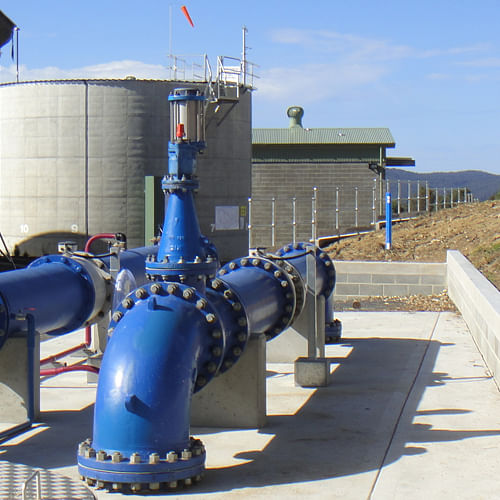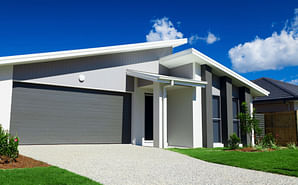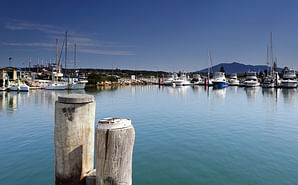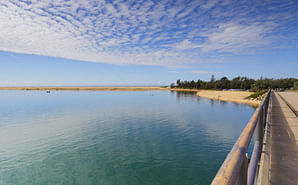Water Supply Infrastructure
Infrastructure is vital for a safe and efficient supply of water to customers.
 The infrastructure network
The infrastructure network
Water supply assets in the Bega Valley Shire consist of:
- 179 kms of water trunk mains
- 346 kms of water reticulation mains
- 50 water storage reservoirs
- 3 dams
- 3 weirs
- 11 bores
- 18 water pumping stations
- 7 chlorinators
- 1 fluoride dosing facility
- 42 bulk flowmeters
- 61 pressure and control valves
- 6621 hydrants and valves
- 12,500 customer water connections and meters
The diameter of water mains ranges from 75 mm up to 450 mm. Water mains are made of a variety of materials including cast iron (CI), cast iron cement lined (CICL), asbestos cement (AC), ductile iron cement lined (DICL) and unplasticized polyvinyl chloride (uPVC or Blue Brute). All water storage reservoirs are made of concrete (apart from Bemboka which is steel).
Strategic objectives for water supply assets
Water supply assets are operated and maintained to:
- Provide safe drinking water to all towns and villages
- Provide effective drought security
- Meet defined levels of service
- Provide cost-effective, efficient and reliable water services
Water supply assets and levels of service
Levels of service for water supply assets include:
Design parameters:
- Maximum static pressure for town/village supplies = 90 metres head
- Minimum static pressure for town/village supplies = 20 metres head
- Domestic peak day supply = 2500 Litres per tenement per day
- Ratio of peak day demand to average day demand = 2
Frequency of system failures:
- Total number of water supply interruptions = 35 per 1000 connections per year
Response time to system failures:
- Maximum duration of planned interruptions (towns/villages) = 6 hours
- Average duration of unplanned interruptions (towns/villages) = 2 hours
- Response time for supply failure = 30 minutes (during work hours) 2 hours (after hours)
Asset condition and serviceability
Assets are continually assessed for condition and serviceability. Condition assessment involves consideration of the material used, asset age and the identification of defects and deterioration. Serviceability assessment involves consideration of hydraulic performance, energy efficiency, frequency of maintenance and repairs, break history, water quality complaints and performance in comparison with levels of service.
Asset renewal and new infrastructure programs are based on condition and serviceability assessments.
Assets we own
The overall replacement value of our water supply assets is about $250 million. This includes dams, pipes, tanks, telemetry, pumps and all the other assets we use to deliver a safe and reliable supply of water to our customers. Each year we spend millions of dollars renewing and upgrading these assets. We spend around 2.3% of the total replacement value of our assets on their operation and maintenance each year. We are careful to make sure that we can afford to look after the new assets we build.
More information on our renewal expenditure can be found in the following documents:
- Water Supply Asset Management Plan
- Development Servicing Plan for Water Supply
- Strategic Business Plan for Water Supply and Services
Asset maintenance
Routine maintenance is regular on-going work that is necessary to keep assets operating. Maintenance includes:
- Reactive maintenance (unplanned): to correct malfunctions and failures as required and respond to service and management requests. eg. repairing main breaks and pump failures, repairing service line breaks, flushing mains in response to dirty water issues.
- Proactive maintenance (planned): works to prevent infrastructure failure carried out to a pre-determined schedule. eg. monitoring computer telemetry (reservoir levels, pump hours, pump starts, alarms), monitoring piezometer levels at dams, flushing water mains systematically, exercising valves, purging and cleaning of bores, testing faults and operation of pumps and generators, calibration of monitoring equipment, cleaning and inspecting reservoirs.
- Cyclic maintenance (recurring): replacement of lower value components/sub components on a regular cycle. eg. remarking hydrant and stop-valve locations, replacing oil and water seals, lubricating bearings and motors, replacing gaskets, changing batteries.
Council’s Water and Sewerage Services Area Field Teams and Technical Services Team implement reactive, proactive and cyclic water supply asset maintenance under the supervision of the Water and Sewerage Network Operations Superintendent and the Water and Sewerage Operations Coordinator.
Maintenance Work Reports are completed by the field teams after maintenance works are undertaken. These completed Maintenance Work Reports are provided to the Water and Sewerage Services Management Team to update Council’s AssetPlan asset management system for scheduling investigations and capital upgrades.
Asset renewals
Asset renewals are capital works to restore, rehabilitate, replace or renew water supply assets to their original service potential. Renewals do not increase the design capacity of the assets. Water supply system renewals include:
- Water main replacement – eg. renewals of pipelines that have a history of breaking.
- Pump station renewals – eg. renewals of pumps, switchgear, controls.
- Water meter replacement – eg. replacements of water meters on a 10 year cycle.
New Assets
New water supply assets are required to improve existing assets beyond their capacity and/or to provide a higher level of service. This occurs as a result of growth, social or environmental needs and/or changes to statutory requirements or regulations. Over the next 5 years we are building water treatment plants worth about $30 million to improve the quality of water supplied, to better meet the Australian Drinking Water Guidelines and to better manage source and storage water quality risks (such as algal blooms).






